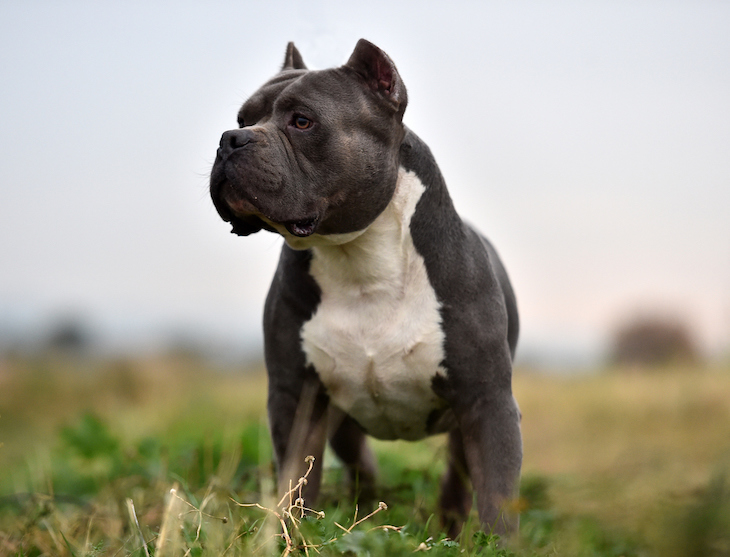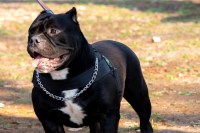The American bully XL is, despite its name and reputation, said to be good with children and a friendly dog. However, it can turn, with terrible consequences.
A father of two young children was killed by a dog, believed to be an XL bully, in Leigh, Greater Manchester, last week. Jonathan Hogg, 37, had apparently been playing with the dog when it suddenly went for his throat. Hogg didn’t stand a chance against such a powerful creature. Since 2021, XL bullies – and one XL cross – have killed seven people in the UK, three of them children: Bella Rae Birch, 17 months, Alice Stones, four, and ten-year-old Jack Lis.
The XL bully is a relatively new, larger version of the American bulldog, which is a modern re-creation of the old bull- and bear-baiting bulldogs of centuries ago, a mix of pit bull, mastiff and other bull dogs. The American and English staffies, along with the banned American pit-bull terrier, all stem from that original bulldog. These pit-bull type dogs are biologically the same, fighting-bred dog.
The ‘blame the deed, not the breed’ thinking has caused carnage and grief
The past week or two has seen a spate of serious dog attacks. The same day the story broke about Hogg, Vick Zidko, six, was scalped by his American staffordshire terrier in Doncaster, and a nine-month old baby was badly mauled in Aldingbourne, West Sussex, by an unnamed breed. It has also been revealed that Surrey dog walker Natasha Johnston, killed in January while out with eight dogs, one a huge leonberger, may have actually been mauled to death by her own XL bully.
Author and dog behaviourist Alexandra Semyonova has written extensively about the selective breeding that took place over the centuries to create dogs for specific tasks. This is aimed at ensuring these animals have the appropriate brains and brawn for the job. The border collie, for instance, with its nimble body and quick thinking, is uniquely suited to herd sheep and loves doing it. The pit bull, with its massive jaws and muscular body combined with the mindset to kill, wants to fight, having been bred for ‘sudden uncontrolled aggression’ and ‘a killing bite’.
Non-fighting bred dogs have their own social system and take pains to avoid conflict. Not so with pit bull-type dogs, which regularly attack and kill dogs, as well as other animals.
There is a huge divide in opinion over these dogs and what should be done about them since they burst onto the scene in the late 90s, as a result of the fashion for ‘weapon’ dogs and gangsta rap that came from America. For years now the dog ‘establishment’, including the Kennel Club, dog charities, behaviourists and trainers, has, with one or two exceptions, maintained that how a dog behaves is down to the owners, not the breed. On its website, the Kennel Club says: ‘No breed of dog is inherently dangerous. Scientific research has proven that the pit bull terrier and related breeds are physiologically no different from any other breed of dog’.
If you tell a pit bull lover that a border collie herds and a retriever retrieves because they have been bred for these activities, they tend to agree. But say that a pit bull is good at fighting for the same reason and they invariably explode, arguing that these dogs have wonderful temperaments if treated properly. But it’s not a question of temperament, it’s about a pattern of behaviour that has been bred into them.
Rescue organisations promote these, and other similar, dogs and even urge people to adopt them. But this can backfire. A woman in Crowborough, East Sussex, has had her arm amputated after the American bulldog she was fostering for the RSPCA mauled her. Joanna Harris is suing the charity for £200,000 because, she claims, it hadn’t told her the dog had previously attacked two women. The dog latched on to her arm and wouldn’t let go until tasered three times by police. The RSPCA says that it ‘assess(es) the health and behavioural needs of animals before rehoming’.
The All-Party Parliamentary Dog Advisory Welfare Group (APDAWG) is supporting an Early Day Motion submitted earlier this month to invite debate on the alarming rise in people getting killed or bitten by dogs. It says an approach based on Breed Specific Legislation (BSL), introduced in 1991 as part of the Dangerous Dogs Act, has failed and that the Dangerous Dogs Act 1991 is woefully ineffective.
The rising number of dog attacks in the UK appears to back up this viewpoint. The number of dog attacks recorded by police in England and Wales has risen by more than a third in the past five years, according to the BBC. Older people remember a time when it was unheard of for anyone to be killed by a dog, because years ago fighting breeds were rarely kept as pets. A glance at Wikipedia’s list of fatal dog attacks shows nearly all deaths are caused by pit bull-type dogs, apart from the odd rottweiler or husky.
The ‘blame the deed, not the breed’ thinking has caused carnage and grief. Most dogs bite and release; what makes pit bull-type dogs uniquely dangerous is that they can latch on and do not let go. People, understandably, can be too terrified to intervene. Such dogs are too dangerous to be pets. You cannot train out their genes. Too many people and animals are being killed or severely mauled. The existing ban should be widened and enforced. Other countries are coming to the same conclusion. It’s time to crack down on Britain’s dangerous dogs, before more people are killed.







Comments
Comments will appear under your real name unless you enter a display name in your account area. Further information can be found in our terms of use.